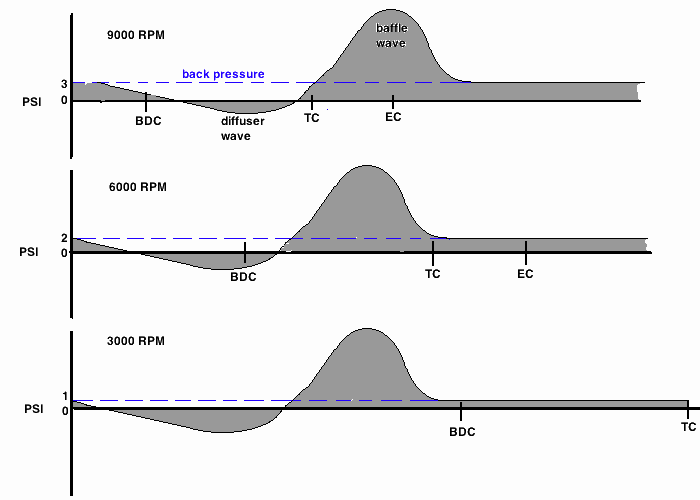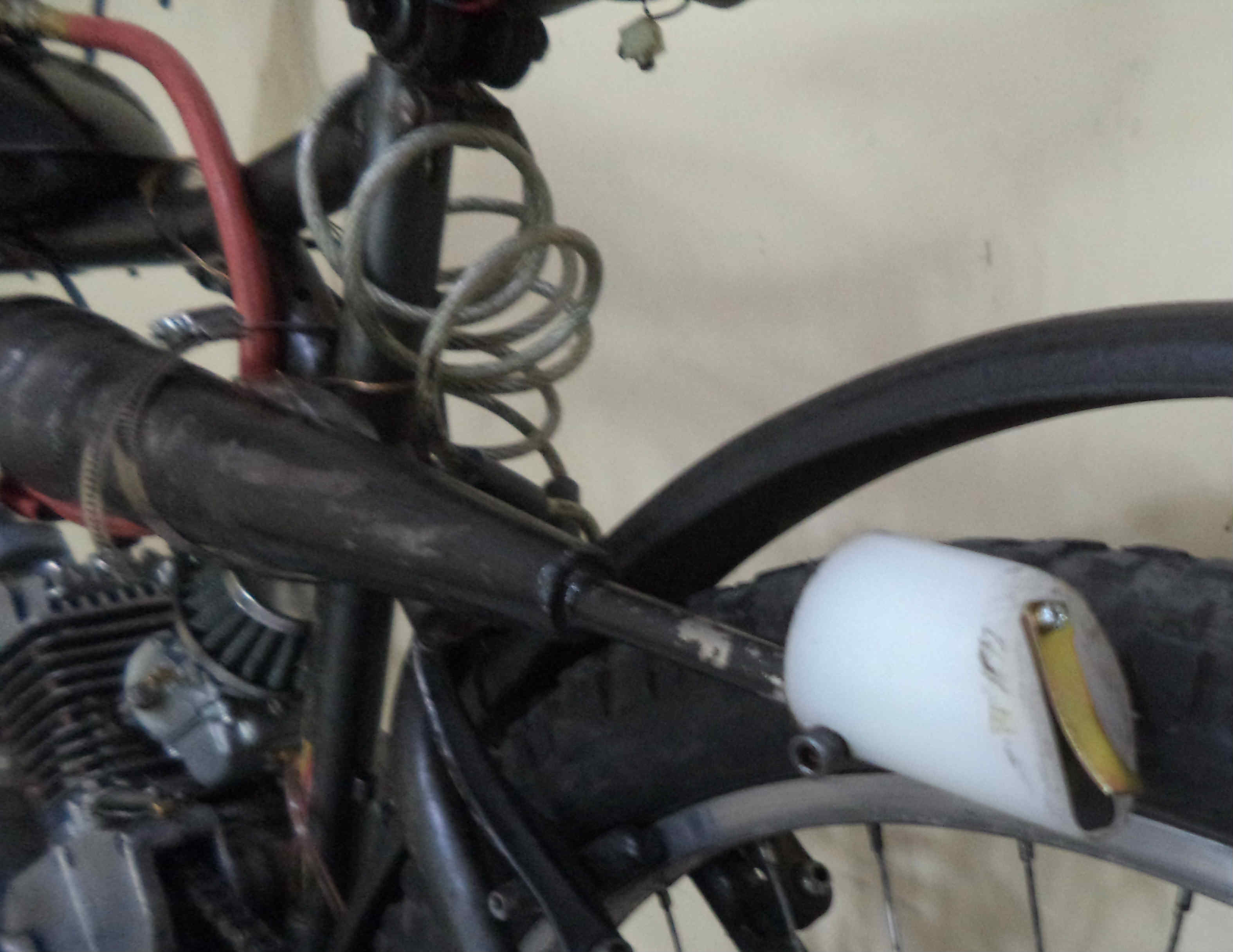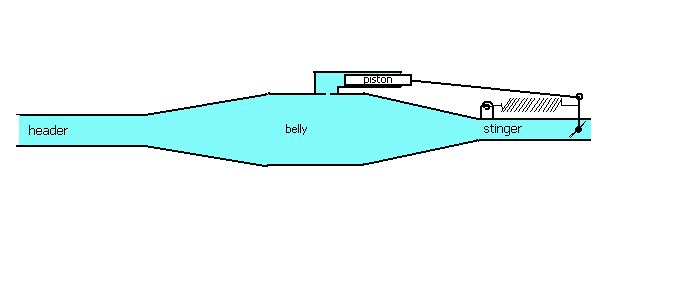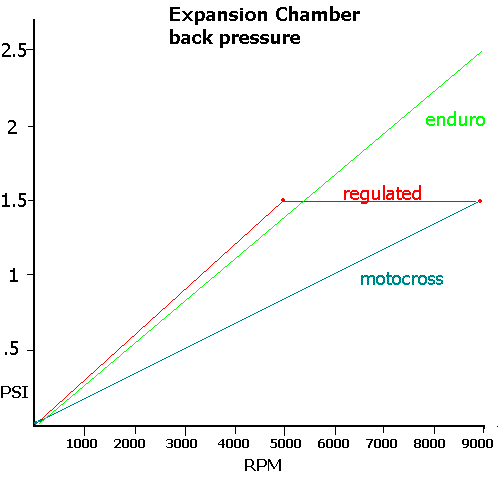|
The stinger determines the pipe back pressure which combines with the diffuser return wave to lessen it, and with the baffle return wave to increase it. The back pressure is relative to engine RPM so that it linearly increases to its peak value at peak RPM. Without any modification by back pressure the pipes return wave pressures from the diffuser and baffle remains the same though throughout the RPM range. The graph below shows the final pressure wave that results from their combination at various RPM (9000, 6000, 3000). Back pressure subtracts from the diffuser wave whose purpose, from upper mid-range to peak RPM, is to aid the transfer of intake from crankcase to cylinder, and at top RPM to prevent the crankcase from sucking into it the same charge or some exhaust gas (still in the cylinder) when the piston is ascending from BDC. So it aids the delivery ratio for more engine power. At peak RPM the transfers need help since there is so little time for the intake transfer. Back pressure is detrimental to upper RPM delivery ratio by its lessening of the diffuser wave. If the back pressure is 3psi at 9ooo RPM then it's 2psi at 6ooo and 1psi at 3ooo. Here's a drawing showing the return waves relative to BDC (bottom dead center), TC (transfers closing), and EC (exhaust closing):  At top RPM pipe back pressure 1) detracts from diffuser wave, 2) adds to baffle wave At mid RPM pipe back pressure 1) causes a positive pressure in the crankcase before TC which limits intake into the crankcase from the carb, 2) prevents some intake charge loss out exhaust port (TC to EC. a 1.25psi increase prevents loss of 5% of cylinder volume) At low RPM pipe back pressure 1) prevents a little bit of charge loss out exhaust port (TC to EC) So at top RPM a strong back pressure would be detrimental. Motocrossers typically have weak diffuser waves and weak back pressure. At mid RPM the back pressure could be helpful or detrimental. Enduro bikes typically have weak baffle waves and more back pressure than MXers. At low RPM the back pressure is only beneficial since the diffuser and baffle wave occur only before BDC. But unfortunately it is too weak to do much good. I wanted to test the effects of increasing the back pressure at low RPM, so I made a custom stinger reed valve for my motorized bicycle. The exhaust flows through a normal channel from stinger to reed valve. The steel reed valve petal I used is for the Suzuki AX100. It mostly just added .5psi to the whole range.  Next I made a butterfly valve inside the stinger that is controlled by piston movement that is controlled by pressure in the belly. Here is a diagram of the system:  Here is a picture of it:  Here is a graph of the pipe pressure (in red) compared to typical pressure curves for an enduro bike and a motocrosser. The regulated pressure makes my pipe seem like an enduro pipe up to 5000 RPM and then like a motocross pipe.  While testing I noticed that top speed was lower with the regulated stinger, so for my engine the regulated 1.5psi is worse than the original .9psi. The 2nd test was for 4000-5000 RPM going uphill. Results: Minimum speed needed at base of hill to be able to climb it 16.5mph regulated stinger 14mph reed valve stinger 13.5mph straight stinger So the straight stinger producing .9psi at top RPM was the best for mid range and top range RPM for my engine. I can't say that would be true for all engines. Someone wrote me that had tested different stinger sizes, using an expensive pressure gauge attached via 1 foot steel braided line to the belly, on his big bore snowmobile (that is used mostly at top RPM of around 8400RPM). He said that his engine preferred 2.5psi. He gave me the specs to his pipe and engine and the measured exhaust gas temperature and my pipe analyzing program revealed that the baffle was so far back on the pipe that it never had the baffle return wave arriving back at the cylinder at top RPM, only around 6000 rpm. So I think the 2.5psi was acting in place of the return wave at top RPM. Since it's hard to completely predict outcomes it is almost always best to test different setups to see what works best. But these test results surprised me. I thought the additional pressure at mid range RPM would help lessen intake charge loss out the exhaust port and therefore boost delivery ratio, and therefore boost power. But the truth is that the back pressure also has a negative affect on intake since it puts a positive pressure into the crankcase that the piston doesn't nullify until it has traveled up a significant amount, to cause a negative pressure to start drawing in gas/air mixture from the carb/reeds. So that lessens the amount of intake drawn in to the crankcase which negatively affects delivery ratio and therefore engine power. I know the reed valve on my engine has a smaller than desired flow area which would limit intake at top RPM but I thought the longer intake time at mid range RPM would make that detail inconsequential. I could be wrong. (ha! like I'm never wrong!) Maybe on an engine with great intake flow area at the reeds the engine may like a higher back pressure. I don't know. If anyone wants to do their own testing and give me some feedback I will receive the info with open arms. The only other factor I can think of which may be important is the crankcase compression ratio. I think mine is about 1.4 to 1, slightly less than the most common 1.5 to 1. What about what Gordon Jennings said in his paper about expansion chambers? You can go by his suggestion of making the stinger diameter 60% of the header diameter, and making its length 12 times the distance of the stinger diameter, which works fine for a well designed pipe. Using that as a guide I figured a 125 reving to 10,000RPM needs a 22mm stinger which provides .08psi back pressure. Jennings and Bell both said that the stinger creates pipe back pressure. I'm inclined to have a stinger that gives somewhere between .1 and .5psi back pressure. * delivery ratio: the ratio of intake charge volume to cylinder volume. Filling 80% of the cylinder gives a ratio of .8 (to 1). The higher the ratio, the better the engine power. |